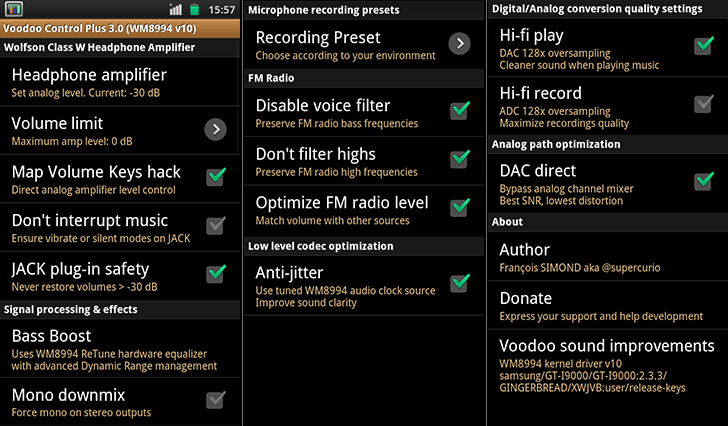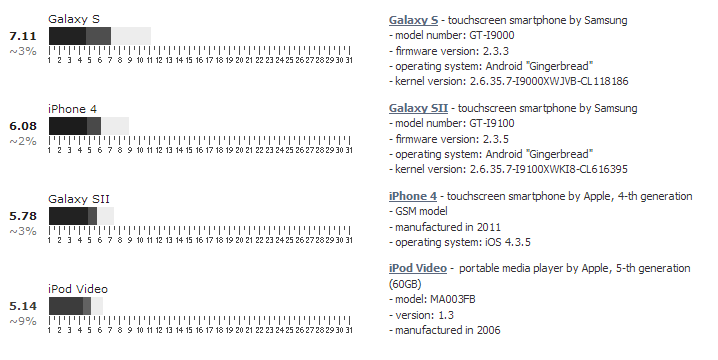This article is obsolete and retained for archival purpose. Listening tests of portable players are no-longer conducted and substituted by objective measurements which are available on portable players page -
http://soundexpert.org/portable-players. The measurements of Galaxy S was not performed due to its low popularity these days.
 |
| Galaxy S
smartphone by Samsung |
This smartphone by Samsung is considered by many as a competitor of iPhone 4. So we desided to add it to our new "Portable players" section side by side with its rival. The model we tested is GT-I9000 with Android "Gingerbread" operating system. Our main conclusions in short:
- Objective measurements show that audio tract of Galaxy S is on a par with similar devices of this class. Final conclusion about its quality can be made only after finishing listening tests when its rating become reliable. Consider taking part in SoundExpert tests.
- If you listen it with wired headphones and satisfied with the loudness, you don't need to upgrade original audio drivers to Voodoo ones. If you upgrade though, you'll get additional output power without quality sacrifice.
- Besides common for all audio players noise and gradual cutting of high frequences Galaxy S has some special flavour of sound – spatial distortion of stereo image. But the level of the degradation is too subtle to be noticed even in perfect cans.
Objective measurements
First of all we failed to get our standard required output level from headphones OUT of Galaxy S, connected to Koss Porta Pro. Even at max volume available with original sound drivers we fell short of 2dB SPL. Actually it's not a big problem for the objective measurements but limitation of output level is obvious and can be a problem for high impedance or low sensitivity headphones.
Difference levels for our standard set of signals and samples are in the Table 1:
Sine@1kHz
86dB SPL | White noise
86dB SPL | J.S.Bach
80dB SPL | Bass
81dB SPL | Castanets
78dB SPL | French
male
speech
82dB SPL | Glockenspiel
76dB SPL | Harpsichord
77dB SPL | Postscriptum
78dB SPL | Mike
Oldfield
81dB SPL | Quartet
83dB SPL |
| -70.85 (L) | -6.15 (L) | -32.00 | -32.26 | -22.17 | -34.50 | -30.59 | -18.60 | -24.82 | -16.69 | -36.52 |
| -70.84 (R) | -6.15 (R) |
Table 1: Difference levels of various signals and samples transfered through Galaxy S with naitive sound drivers. The values show to what extent the waveformes change their shapes passing through device:
-∞ dB - signals passed unchanged, perfectly exact shapes
0 dB – input and output signals have nothing in common
For sinusoidal signals and small Df values Difference level can be easily converted to THD+Noise:
THD+Noise [dB] ≈ Df [dB] + 3 [dB].
Sound pressure levels of samples and signals are unweighted and averaged over 400ms.
The values look good and depend on complexity of signals; nothing extraodinary. If you like to listen the sine wave @1kHz at the output of Galaxy S with artifacts amplification +71dB refer to Audio 1:
Download this Audio in lossless format FLAC:1.24MB
Audio 1 Sinusoidal signal (@1kHz, 86dB SPL unweighted) at the output of Galaxy S with sound artifacts amplified to +71dB
The sine signal is deeply buried in noise. The origin of its audible fluctuations is unclear. Our guess – it is headphones amplifier of class W at work. Galaxy S uses Walfson WM8994 audio hub with integrated power amplifier of this class. Such amplifires dinamicly adjust voltage level for their output stages maximizing efficiency and reducing heat dissipation this way. The adjustments are made discretely depending on power required at each moment. So what we hear is probably some modulation of signal by those adjustments fluctuating around optimum voltage value (as the signal level is costant). If somebody can suggest better explanation, please, drop us a line. And yes, this pecularity doesn't depend on audio drivers, software players, input files (WAV or FLAC) and specific to Galaxy S only.
In any case this oddity at the level of -70dB doesn't affect real-life listening experience but can be interesting for developers of amplifires.
Also, despite heavy isolation of headphones from background noise during recording, some of our voices are noticable at this level of artifacts amplification. We'll find who cried louder than others during that particular recording and punish demonstratively  . All future recordings will be made in silence. Promise.
. All future recordings will be made in silence. Promise.
Voodoo audio drivers
Opensource project Voodoo originated by François Simond aka supercurio from xda-developers forums developed alternative and very popular audio drivers. They unlock full power of headphones amplifier and make possible some low level tunings of WM8994 chip which improve sound quality. For assessment of those improvements we installed Voodoo Control Plus 3.0 (WM8994 v10) with the following settings (Figure 2):

Figure 2 Settings of Voodoo sound drivers we used
Now we could easily achieve required sound pressure level. Results of our standard measurements are in the Table 2.
Sine@1kHz
88dB SPL | White noise
88dB SPL | J.S.Bach
82dB SPL | Bass
83dB SPL | Castanets
80dB SPL | French
male
speech
84dB SPL | Glockenspiel
77dB SPL | Harpsichord
79dB SPL | Postscriptum
80dB SPL | Mike
Oldfield
83dB SPL | Quartet
85dB SPL |
| -72.87 (L) | -6.15 (L) | -32.15 | -32.48 | -22.19 | -34.58 | -30.65 | -18.67 | -24.97 | -16.97 | -36.68 |
| -72.90 (R) | -6.15 (R) |
Table 2: Difference levels of various signals and samples transfered through Galaxy S with Voodoo sound drivers. The values show to what extent the waveformes change their shapes passing through device:
-∞ dB - signals passed unchanged, perfectly exact shapes
0 dB – input and output signals have nothing in common
For sinusoidal signals and small Df values Difference level can be easily converted to THD+Noise:
THD+Noise [dB] ≈ Df [dB] + 3 [dB].
Sound pressure levels of samples and signals are unweighted and averaged over 400ms.
The improvements are not dramatic. Audible difference is also very subtle and illustrated by the piano excerpt (Audio 2):
Download this Audio in lossless format FLAC:1.21MB
Audio 2 Piano excerpt played back on Galaxy S using Voodoo (1) and original (2) sound drivers. In both samples sound artifacts are amplified to +32dB. The second one (with original sound drivers) has a bit more noise and more "dirty" high frequences because they are reproduced less accurately. Though the difference is very subtle even with this huge artifacts amplification.
Taking into account that quantative improvements, measured with Diff. Level, are within 0.1dB for real-life signals and audible difference is faintly discernible, we can safely conclude that such improvements are far beyond the threshold of human perception. Original sound drivers in this sense are similar to Voodoo ones. So if there is no need for additional output power from your Galaxy S (very reasonable self-restriction nowadays), there is no necessity to install Voodoo drivers. In case of using some headphones with low sensitivity or high impedance or both Voodoo drivers will help to drive those cans without loosing audio quality.
Sound flavoring
Another feature of Galaxy S sound is some subtle flavoring caused by small and unusual cross-talk between stereo channels. It is unusual because amplitude and phase of signal penetrating into neighboring channel are frequency dependent. In most cases penetrating signal consists of middle-to-high frequencies, has inverted polarity and amplitude -40dB (and lower) below level of main signal in channel. In order to assess consequences of such cross-talk we prepared two stereo recordings – one usual with cross-talk and one without. For the purpose the piano sample, played back by Galaxy S, was recorded three times – left and right channels separately and in stereo as usual. Then left and right channels were combined in stereo thus completely eliminating any cross-talk in this stereo recording. In both stereo recordings sound artifacts were amplified to +16dB. Audio 3 presents result of the experiment. It consists of three samples – original piano excerpt, played back version without cross-talk and version with cross-talk.
Download this Audio in lossless format FLAC:1.42MB
Audio 3 Three sound samples show the influence of cross-talk in Galaxy S on resulting sound quality. First sample is a reference piano sample. Second – the same sample played back by Galaxy S without cross-talk (left and right channels were recorded separately). Third sample was played back and recorded in stereo normally thus it is affected by cross-talk. Sound artifacts of two last samples were amplified to +16dB making the difference between samples more audible.
In the third sample (affected by cross-talk) sound image is spread among channels as if it would been processed by spatializer. If it were not for so low levels of this cross-talk we would suppose it was made in purpose. Cross-mixing of stereo channels with inverted polarity is often used for widening of stereo base in various sound enhancers. But in this case we rather suppose it is a side effect of analog circuitry design, again the headphones amplifier most likely. The effect becomes audible only with pretty high levels of artifacts amplification (+12dB and more). At these levels increased noise and absence of high frequencies are already revealed vividly in sound, so the results of this small cross-talk can hardly be heard in real-life.
All changes a sound undergoes passing through Galaxy S can be summarized as follows:
| Sound artifacts amplification applied, dB | Revealed artifacts |
| +7 ... +10 | Usual broadband noise |
| +10 ... +12 | Lack of high frequencies |
| +12 ... +15 | Diluting of stereo image |
| +70 and more | Discrete switching peculiarity |
Table 3 Various sound artifacts revealed at different levels of artifacts amplification
All these types of sound degradation in various combinations (except the last one which is reliably masked by the three first) are present in test files of Galaxy S uploaded to SE testing engine. Listening tests will show how far these sound drawbacks lay beyond threshold of human perception.
As usually we would like to thank some people. First of all Kirill who placed his smartphone to our disposal and patiently performed all reconfigurations and modifications necessary for more than dozen recordings we made using different settings. His Galaxy S was not hurt during those inhuman tests. When most of the work was finished we received suggestion from Alex to include Galaxy S and S II to SE testing. It was encouraging, thanks.
We in our turn encourage You to take part in SoundExpert listening tests. All SE ratings, including newly added Galaxy S, exist only thanks to visitors like you. Testing is short and easy,
visit our listening room for simple 1-2-3 instruction. Thank you in advance!
Please, remember, downloading a test file from SoundExpert you will not necessarily get a test file of Galaxy S. SE testing is blind testing – you don't know the device you test. This is the only reliable way of getting true audio quality ratings, free from any cheating and various human senses other than perception of sound quality. After you have sent your grade you will see the device you tested.
And some bad news at the end. Bad news for iPhone 4. No, it is not a looser in comparison with Galaxy S. Our extensive research testing of the latter revealed that test files of iPhone 4 that already in the system were prepared with not sufficient accuracy. For fair comparison of portable players they must be replaced. This will be done within a few days followed by corresponding notification in SE news. Sorry for that.
SE Team.
Update. 2015 August 22
Deprecated results of previous listening test of Portable Players. For archival purposes only.
